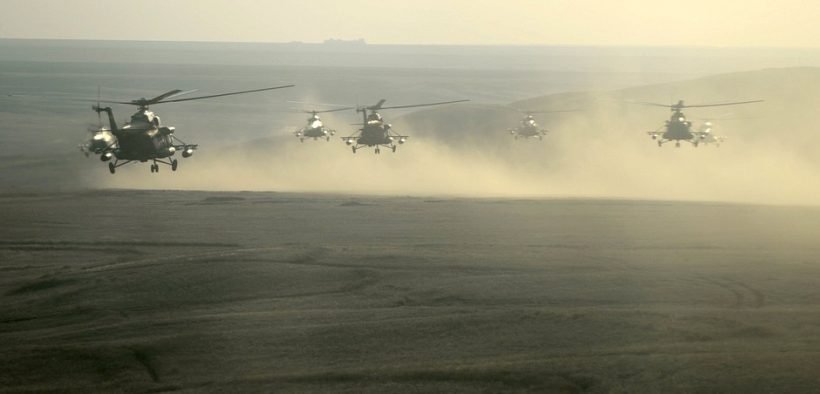Russia, China and Central Asian Nations Hold First Ever Joint Military Exercise

“Russia has traditionally considered Central Asia, including Tajikistan, as its sphere of political-military influence.”
Despite being engaged in an ongoing struggle for influence in Central Asia, Russia joined China and a handful of other Asian nations (Kazakhstan, Kyrgyzstan, Tajikistan, Uzbekistan and archrivals India and Pakistan) in kicking off a series of large-scale military drills on Monday.
The drill, known as “Tsentr-2019,” began in Orenburg, south of the Urals in Russia which is near Kazakhstan. According to UPI, troops from several Central Asian states, India and Pakistan (which have been involved in tensions over the disputed Kashmir region), will train in Astrakhan Oblast, the North Caucasus region of the Russian republic of Dagestan, Chelyabinsk Oblast, the Siberian Altai and Kemerovo.
Russia’s Ministry of Defense reported the six-day exercise will involve 15 warships, 600 military aircraft and around 130,000 soldiers with 20,000 military devices.
Only Kazakhstan has participated in a previous joint multilateral exercise with Russia; Tsentr 2015 involved 95,000 troops and fewer than 10,000 units of the military equipment. This years drill is also noteworthy for the joint participation of Pakistan and India, traditionally bitter rivals who are currently engaged in heightened tensions over the long-standing Kashmir dispute. The joint-exercise aims to boost cooperation to tackle international terrorism and prevent Islamic extremists from entering Russia through Central Asia, Moscow said.
The drill will consist of two stages: phase one will focus on upgrading the control and command of troops and taking measures to counter airstrikes and defensive operations, while the second stage will see how the participating countries will launch an attack against an imaginary terrorist, as Moneycontrol reported.
The Russian-Chinese Relationship
Russia-China cooperation has strengthened in the past few years as both countries have found each other on the same side recently when it comes to dealing with the U.S. However, they still see each other as rivals, given they are trying to boost their dominance in the Asia Pacific region.
Before the Tsentr drill, China and Tajikistan held a joint military exercise in early August for eight days, as South China Morning Post (SCMP) reported. The training took place in the Gorno-Badakhshan autonomous region, bordering China’s volatile Xinjiang province and Afghanistan.
Such a drill hinted at China’s growing influence in Central Asia’s backyard, once viewed as under Russia’s influence during the Cold War (when Russia was known as the Soviet Union). Some observers have said that Moscow is not comfortable watching Beijing’s more significant power in Tajikistan.
“Russia has traditionally considered Central Asia, including Tajikistan, as its sphere of political-military influence,” Artyom Lukin, an international politics professor at Vladivostok’s Far Eastern Federal University, told SCMP.
Tajikistan is politically and geographically vital to China. First, the Central Asia nation borders with Xinjiang, the predominantly-Muslim region where Beijing has been slammed for human rights violation against Ughiur Muslims. Second, Tajikistan’s strategic location along a key trade route is seen as an opportunity for Beijing to widen its influence through infrastructure development, investment and trade under its ambitious One Belt One Road (OBOR) scheme.
An independent research body, the International Crisis Group, reported China’s military intensified its military presence in Tajikistan by deploying troops amid concern that militant groups based in Afghanistan could infilitrate West China, as DAWN reported in March of 2018.
China has also repeatedly warned that Ughiur militants leaving their hometowns in West China might be joining militant groups such as the Turkistan Islamic Party, a Ughiur-dominated party with bases in Syria and Afghanistan and affiliated with the Taliban and Al-Qaeda.
China has been Tajikistan’s largest investor, outside of Russia. In 2016, China’s investment in Tajikistan contributed to 30 percent of the latter’s total investment, as SCMP quoted from Xinhua.
China’s Growing Military Industry in Central Asia
When the Soviet Union collapsed, China relied heavily on the technology of former Soviet states now known as Central Asia. As an example, in 1998, China bought 40 units of Shkval torpedoes from Kazakhstan.
However, things have changed rapidly since then. China’s innovation in building its own military technology has lured the interest and dollars of Central Asian nations, while Russia is now left to catch up and boost innovation in its defense sector.
As Yau Tsz Yan wrote for The Diplomat, “The close to nonexistent manufacturing sector for military parts in Russia continues to give China an upper hand in producing traditional components as well as new military-use telecommunication components. In 2015, 186 types of Russian military equipment needed components from manufacturers in Ukraine. On top of all this, huge debt in the Russian military industry will only make cheaper Chinese alternatives more and more attractive.”
Cleverly, as Yau Tsz Yan points out, China’s military tech has purposefully developed armaments that fit existing Soviet weaponry already in the hands of Central Asian countries, making such technology especially attractive.
China’s growing military presence coupled with its ambitious Belt and Road Initiative suggests China’s sphere of influence in Central Asia will continue to grow at impressive rates.
The question is whether the cooperation seen between China and Russia at Tsentr-2019 is a sign that Russia will welcome and work with China’s growing influence in Central Asia.







